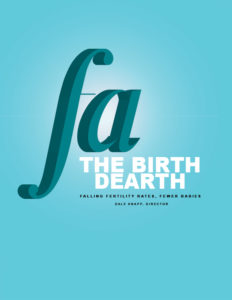“The Birth Dearth: Falling Fertility Rates, Fewer Babies”

With the number of births in Wisconsin continuing to decline, the state could be headed toward a natural decrease in population, where deaths exceed births, by 2026. This is one of several important findings in “The Birth Dearth: Falling Fertility Rates, Fewer Babies”, a new report from Forward Analytics.
“During 2007-2018, the number of babies born in Wisconsin declined more than 12% to just over 64,000, the fewest since 1973,” said Forward Analytics Director Dale Knapp. “The general fertility rate, or the rate at which women ages 15 to 44 give birth, declined to its lowest level since 2002.”
He continued, “While these patterns are troubling for a state with significant demographic challenges, a deeper dive into the numbers shows some positive trends. Much of the decline in both births and birth rates is due to a large drop in teen pregnancy.”
Decline in Teen Births
During 2007-2017, the number of babies born to teen mothers dropped from 6,320 to under 2,600. The decline in teen fertility rates after 2007 accounted for more than 40% of the reduced number of births and three quarters of the fall in general fertility.
“For decades, policy makers have focused on reducing teen pregnancy because teen mothers are often unprepared for parenthood and are more likely to be single parents,” said Knapp. “We know children born to teen mothers are more likely to live in poverty, struggle to acquire basic literacy skills, and underperform in school. They are also more likely to continue that cycle by becoming teen mothers themselves.”
Delay in Childbirth
A second factor in Wisconsin’s “birth dearth” appears to be a delay in childbirth. Since 2007, birth rates among women 20 to 24 years old have declined precipitously, while rates for women in their 30s have climbed. During 2007-2017, the median age of a mother having her first-born child increased almost two years, from 24.3 to 26.2. Some of the increase was driven by reductions in teen births.
Inability to Retain Millennials
A third factor, the inability to retain millennials, portends long-term challenges for the state. As the oldest millennials – those who were 15 to 19 years old in 2000 – aged into their late 20s and early 30s when fertility rates are highest, their numbers in Wisconsin declined nearly 8%. Among women five years younger, those who were 15 to 19 in 2005, declines were significantly larger. As the state loses these young women, and possibly those in Generation Z behind them, it can expect fewer babies in the future.
“It is worth noting that the decline in births and birth rates facing Wisconsin is also occurring across the country,” said Knapp. “Failure to reverse this trend could have significant consequences for economic growth and for the funding of major federal programs such as Social Security and Medicare.”
He concluded, “There are no easy answers, but we only have to look to Japan to see some of the consequences of declining fertility and births, including a rapidly aging population and a shrinking workforce.”
Read the full report, The Birth Dearth: Falling Fertility Rates, Fewer Babies, here.
